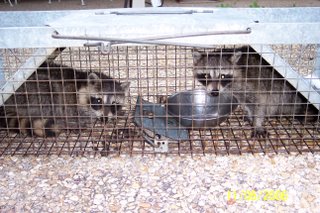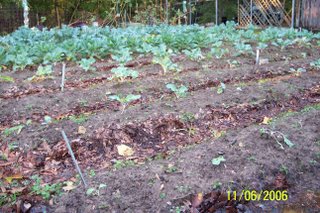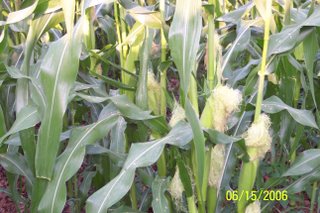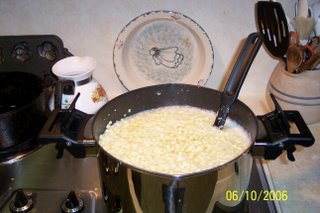From Cole to Cold


Anything and everything related to growing things or things grown around the home... flowers, vegetables, birds, recipes, just whatever..




Now I'm it trouble! This happens every June when my 2000-plus square foot garden comes into production.
 This chore is easily not a one-man task; I need help. And my wife Brenda is not always enthusiastic about the "mess" and about the helping part. Some of her comments are: "This is your hobby, not mine." "Why do you grow so much?" "Who is going to eat all of this stuff?" "It wasn't my idea to grow corn in the first place." "Do we NEED to grow all of those tomatoes, corn, eggplant, etc."? "Why do we make so many jars of pickles; you don't even eat the pickles?" "Our house looks like a produce market." ...etc..
This chore is easily not a one-man task; I need help. And my wife Brenda is not always enthusiastic about the "mess" and about the helping part. Some of her comments are: "This is your hobby, not mine." "Why do you grow so much?" "Who is going to eat all of this stuff?" "It wasn't my idea to grow corn in the first place." "Do we NEED to grow all of those tomatoes, corn, eggplant, etc."? "Why do we make so many jars of pickles; you don't even eat the pickles?" "Our house looks like a produce market." ...etc.. Much are consumed while fresh and some are canned or frozen. During the months that follow harvest, we seem to have a fairly steady flow of frozen vegetables going from the freezer to our kids, mostly Mitsie, but sometimes April and Mark. Now our grandchildren 4-year-old Benjamin and 2-year-old Carter are also delving into the frozen produce. Every one seems to have a favorite - Mitsie loves sweet corn, Benjamin loves broccoli and Carter loves green beans. Brenda likes the frozen strawberries in strawberry daiquiris. (So I try to keep the frozen strawberry daiquiri container in the freezer from going empty.)
Much are consumed while fresh and some are canned or frozen. During the months that follow harvest, we seem to have a fairly steady flow of frozen vegetables going from the freezer to our kids, mostly Mitsie, but sometimes April and Mark. Now our grandchildren 4-year-old Benjamin and 2-year-old Carter are also delving into the frozen produce. Every one seems to have a favorite - Mitsie loves sweet corn, Benjamin loves broccoli and Carter loves green beans. Brenda likes the frozen strawberries in strawberry daiquiris. (So I try to keep the frozen strawberry daiquiri container in the freezer from going empty.) (The photo at the left is just the morning harvest.) The squash, peppers, blueberries, and asparagus beans are coming in at a "controlled rate". All will be put to a good use. Much will be given away, much will be eaten, and much will frozen or canned. Time will be needed for the latter.
(The photo at the left is just the morning harvest.) The squash, peppers, blueberries, and asparagus beans are coming in at a "controlled rate". All will be put to a good use. Much will be given away, much will be eaten, and much will frozen or canned. Time will be needed for the latter.Spring and soon-to-be Summer are here once again to play out another "vegetable gardening" chorus.
 And so the process began in early March with the first clearing of the winter garden and churning of the soil. This was the followed by a second April clearing and tilling. An early May harvest of the fall planted garlic and onions making space for the last of the Spring garden rows. So just this last mid-May weekend the final Spring/Summer garden 2007 tilling was done.
And so the process began in early March with the first clearing of the winter garden and churning of the soil. This was the followed by a second April clearing and tilling. An early May harvest of the fall planted garlic and onions making space for the last of the Spring garden rows. So just this last mid-May weekend the final Spring/Summer garden 2007 tilling was done.




This last weekend marked the completion Fall 2006 garden tilling. It was one of those typical November days where the temperature barely makes it to 70 degrees and a mild breeze was blowing. A perfect day for gardening! The soil was a bit damp from heavy rains about a week or so before which made the tilled soil a bit clumpy, but not to the point of being too hard to work. Nonetheless, it was a now or possibly never situation as more rains were forecasted for the upcoming week. The routine was to first take down the electric fence to allow access by the garden tiller. Then after digging up the last of the summer peanut crop, removing invading roots from a nearby tree, digging up miscellaneous weeds, nut grass and a bit of bermuda grass, tilling, spreading a bit of fertilizer, hand working the tilled soil into rows with shovels and rakes, and finally re-installation of the electric fence, the job was done. These activities took a few hours of clock time to complete. Seems like each year the process takes a bit longer than the year before. I seem to be finding each year more truth to the popular Toby Keith song "I ain't as good as I once was"..


 Who'd of thought it. Never before had I caught two of anything in the trap at the same time. So my current count is 6 raccoons since September.. and wondering how many more to go... It turns out there is at least one more out there as the cat food bowl was once again clean as could be this morning.
Who'd of thought it. Never before had I caught two of anything in the trap at the same time. So my current count is 6 raccoons since September.. and wondering how many more to go... It turns out there is at least one more out there as the cat food bowl was once again clean as could be this morning.
I've always preferred a fall/winter garden over a spring/summer one. The reasons are simple. First off, gardening is a much more pleasant activity in south Louisiana during the cool fall and winter months than during the warm, hot, and humid spring and summer. Also, there are fewer insect pests and fewer weeds to deal with during the cooler weather making maintenance much less. And last but not least, my favorite vegetables are broccoli and  cauliflower which seem to do best in fall Louisiana weather.
cauliflower which seem to do best in fall Louisiana weather.
The front-end work effort in getting the Fall garden ready is the toughest part of fall gardening. Clearing out the older spring and summer vegetables and tilling up the soil takes a fair amount of time, particularly for a 2000 plus square foot garden. The weather in August and early September can be quite hot and humid for the initial garden prep. It definitely helps when the there is a temperature and/or humidity drop on an early cool front. However, this is not something that happens too often in August and early September.  Plus, when a pleasant period does occur, it's usually not on the "free-time" days available for gardening activity - some of us still have "regular" jobs and need to work. Secondly, it doesn't help much when the temperature and humidity cooperate following a heavy rain, as this makes the ground too wet for clearing and re-tilling. Nonetheless, if one wants to partake of the fall veges then one needs to do the up-front work required regardless of the obstacles.
Plus, when a pleasant period does occur, it's usually not on the "free-time" days available for gardening activity - some of us still have "regular" jobs and need to work. Secondly, it doesn't help much when the temperature and humidity cooperate following a heavy rain, as this makes the ground too wet for clearing and re-tilling. Nonetheless, if one wants to partake of the fall veges then one needs to do the up-front work required regardless of the obstacles. 
The first clearout and re-tilling has now been completed. About half of the garden space is now available for the fall broccoli, cauliflower, brussels sprouts, and cabbage. The plants grown from seed planted in August and early September are slowly ready to set out in the garden. By early October about 180 of these plants will have been transplanted into the fall garden. Many folks have indicated that this number is more than necessary. But we do have lot of family and friends who enjoy the harvest.  I was just reminded by my daughter Mitsie that my 3 year old grandson Benjamin LOVES broccoli. Hopefully his younger brother Carter will come to enjoy this fall vegetable. (So I surely need to compensate for this - So what do you think, Mitsie? Is an extra 25 plants OK for the boys?) I have also learned over the years that overplanting is a safeguard to compensate for when mother nature is not quite as good to us as she has been in years past.
I was just reminded by my daughter Mitsie that my 3 year old grandson Benjamin LOVES broccoli. Hopefully his younger brother Carter will come to enjoy this fall vegetable. (So I surely need to compensate for this - So what do you think, Mitsie? Is an extra 25 plants OK for the boys?) I have also learned over the years that overplanting is a safeguard to compensate for when mother nature is not quite as good to us as she has been in years past.
The 2nd garden clearout was completed early October. This area will be allocated to strawberries, radishes, lettuce and spinach, which are planted in October. Strawberries planted in the fall are harvested the following spring. So I guess strawberries would be classified as a fall-planted spring-crop. The final clearout will coincide digging of the last 2 rows of peanuts during October. Love those boiled peanuts! This remaining area will be dedicated to onions.
The third week of September had started a trend where low temperatures dipped into the upper 50's thereby signaling the start of serious fall gardening weather. Soon after the temperature highs were back into upper 80's. But one would think that the high humidity and 90 degree plus days were on the way out thereby making the second October garden clearout more tolerable than the first. It didn't happen. With high humidity and temperatures in the 90's, the second clearout was almost as brutal as the first. 
But the garden "spring-out" and "fall-in" is essentially complete. All but about 20 or so broccoli and cauliflower plants have been set out. It's time to sit back, do a bit of maintenance, and just watch 'em grow. .. and they really NEED to grow this year. For I surely don't want to dissapoint my grandsons.




